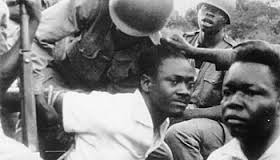Patrice Lumumba/Assassination
 | |
| Date | 17 January 1961 |
|---|---|
In September, the President dismissed Lumumba from government. Lumumba immediately protested the legality of the President's actions. In retaliation, Lumumba declared Kasa-Vubu deposed and won a vote of confidence in the Senate, while the newly appointed prime minister failed to gain parliament's confidence. The country was torn by two political groups claiming legal power over the country.
On 14 September, a coup d’état organised by Colonel Mobutu Sese Seko incapacitated both Lumumba and Kasa-Vubu. Lumumba was placed under house arrest at the Prime Minister's residence, although UN troops were positioned around the house to protect him. Nevertheless, Lumumba decided to rouse his supporters in Haut-Congo. Smuggled out of his residence at night, he escaped to Kisangani (Stanleyville), where his intention apparently was to set up his own government and army.[1]
Pursued by troops loyal to Mobutu he was finally captured in Port Francqui on 1 December 1960 and flown to Kinshasa (Léopoldville) in ropes, not handcuffs. Mobutu claimed Lumumba would be tried for inciting the army to rebellion and other crimes.
Contents
UN response
United Nations Secretary General Dag Hammarskjöld made an appeal to Kasa-Vubu asking that Lumumba be treated according to due process of law. The USSR denounced Hammarskjöld and the Western powers as responsible for Lumumba's arrest and demanded his release.
The UN Security Council was called into session on 7 December 1960 to consider Soviet demands that the UN seek Lumumba's immediate release, the immediate restoration of Lumumba as head of the Congo government, the disarming of the forces of Mobutu, and the immediate evacuation of Belgians from the Congo. Hammarskjöld, answering Soviet attacks against his Congo operations, said that if the UN forces were withdrawn from the Congo "I fear everything will crumble."
The threat to the UN cause was intensified by the announcement of the withdrawal of their contingents by Yugoslavia, the United Arab Republic, Ceylon, Indonesia, Morocco and Guinea. The pro-Lumumba resolution was defeated on 14 December 1960 by a vote of 8–2. On the same day, a Western resolution that would have given Dag Hammarskjöld increased powers to deal with the Congo situation was vetoed by the Soviet Union.
Final days
Lumumba was sent first on 3 December, to Thysville military barracks Camp Hardy, 150 km (about 100 miles) from Léopoldville. However, when security and disciplinary breaches threatened his safety, it was decided that he should be transferred to the State of Katanga, which had recently declared independence from Congo.
Lumumba was forcibly restrained on the flight to Elizabethville (now Lubumbashi) on 17 January 1961.[2] On arrival, he was conducted under arrest to Brouwez House where he was brutally beaten and tortured by Katangan and Belgian officers,[3] while President Tshombe and his cabinet decided what to do with him.[4][5][6]
Murder by firing squad
Later that night, Lumumba was driven to an isolated spot where three firing squads had been assembled. The Belgian Commission (see below) has found that the execution was carried out by Katanga's authorities.
It reported that President Tshombe and two other ministers were present with four Belgian officers under the command of Katangan authorities. Lumumba and two ministers from his newly formed independent government (and who had also been tortured), Maurice Mpolo and Joseph Okito, were lined up against a tree and shot one at a time. The execution probably took place on 17 January 1961 between 21:40 and 21:43 according to the Belgian report.
Delayed announcement
No statement was released until three weeks later despite rumours that Lumumba was dead. His death was formally announced on Katangan radio, when it was alleged that he escaped and was killed by enraged villagers.
After the announcement of Lumumba's death, street protests were organised in several European countries; in Belgrade, capital of Yugoslavia, protesters sacked the Belgian embassy and confronted the police, and in London a crowd marched from Trafalgar Square to the Belgian embassy, where a letter of protest was delivered and where protesters clashed with police.[7] A demonstration at the United Nations Security Council turned violent and spilled over into the streets of New York City.[8][9]
Foreign involvement
According to Democracy Now!, "Lumumba's pan-Africanism and his vision of a united Congo gained him many enemies. Both Belgium and the United States actively sought to have him killed. The CIA ordered his assassination but could not complete the job. Instead, the United States and Belgium covertly funneled cash and aid to rival politicians
- ↑ Longman History of Africa, Snellgrove L. and Greenberg K., Longman, London (1973)
- ↑
{{URL|example.com|optional display text}}00.35.38–00.35.49 - ↑ Prados, John (2006). Safe for Democracy: The Secret Wars of the CIA. Rowman & Littlefield. p. 278. ISBN 9781566638234.Page Module:Citation/CS1/styles.css must have content model "Sanitized CSS" for TemplateStyles (current model is "Scribunto").
- ↑ De Witte, Ludo (2001). The Assassination of Lumumba. Verso Books. p. 136. ISBN 1859844103.Page Module:Citation/CS1/styles.css must have content model "Sanitized CSS" for TemplateStyles (current model is "Scribunto").
- ↑
{{URL|example.com|optional display text}} - ↑
{{URL|example.com|optional display text}} - ↑
{{URL|example.com|optional display text}} - ↑ Mahoney, JFK (1983), p. 72. "In the United States, the news of Lumumba's murder provoked racial riots. During an address by Ambassador Stevenson before the Security Council, a demonstration led by American blacks began in the visitors gallery. It quickly turned into a riot in which eighteen UN guards, two newsmen, and two protestors were injured. Outside of the UN building, fights between whites and blacks broke out. A large protest march into Times Square was halted by mounted police."
- ↑ "Screaming Demonstrators Riot In United Nations Security Council", Lodi News-Sentinel (UPI), 16 February 1961.